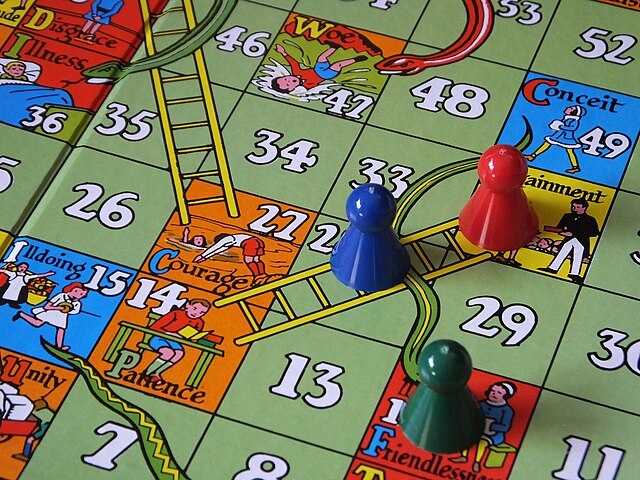If, after reading the title, your immediate response is to shout  1/6-th
1/6-th , then you have correctly answered the question. Well done! However, in this article we will not focus on the answer, but on the meaning of the question itself. What exactly is this
, then you have correctly answered the question. Well done! However, in this article we will not focus on the answer, but on the meaning of the question itself. What exactly is this  chance
chance of which you've just exclaimed it equals 1/6-th?
of which you've just exclaimed it equals 1/6-th?
The mathematical theory of probability calculus was originally developed around 1654 in the correspondences between the French mathematicians Pascal and Fermat to answer certain questions about games of chance and gambling. Nowadays, it is applied successfully in a wide range of topics, many of which are unrelated to games of chance.
The main question of this article  What are probabilities?
What are probabilities? is itself not a mathematical question that can be answered using the probability calculus. Rather it is a philosophical question, investigating for which real world problems the mathematical probability theory can be used.
is itself not a mathematical question that can be answered using the probability calculus. Rather it is a philosophical question, investigating for which real world problems the mathematical probability theory can be used.
Why is it important to understand what probabilities are?
Probabilities are not restricted to dice, cards or other games of chance. Everyone has to account for uncertainty in their daily lives.
Whenever you go outside, you might consult a weather forecast beforehand to help you decide whether to bring an umbrella or not. If the forecast says there is only a 1% chance of rain, then the extra effort of bringing an umbrella might not be worth the risk of getting wet, while a 50% chance of rain might be sufficient to carry an umbrella around.

Image from yesofcorsa.com.
The decisions you make can have far more catastrophic consequences than just getting wet. Traveling by train is safer than traveling by car. So, every time you travel you have to weigh the convenience of traveling by car against its higher chance of having a traffic accident. Though, admittedly, not many people will consciously make a pros-and-cons list of all their travel options. Probabilities also have ethical and moral implications. Judges have to decide how likely it is that a suspect is guilty based on the provided evidence.
A misunderstanding of how probabilities work could lead to erroneous rulings in court. A famous example is the case of Lucia de Berk, who was tried for a number of suspicious deaths that occurred during her hospital shifts. Due to both miscomputation and misinterpretation of the probability that these deaths occurred by chance, she was wrongfully convicted to life imprisonment.
Since probabilities are so pervasive in many aspects of our lives, it might be beneficial to better understand how probabilities work and what they are exactly. While most people will have an intuitive understanding of probabilities, trying to understand what probabilities are and how to interpret them is still an active topic of research in philosophy. This article will not cover the recent developments in this field of research. Rather we will briefly explore the four main schools of thought regarding this subject, and see that none of these gives a completely satisfactory answer to the problem.
Classical interpretation
The first probability interpretation that we will discuss is the classical interpretation, which is so named as it is the oldest interpretation that was developed. It originated in the 17th century together with the probability calculus itself, but its best known proponent is Laplace with his Essai philosophique sur les probabilités from 1814. More recently, in 1968, a variant of this interpretation has been put forward by Jaynes.
This interpretation uses the principle of indifference, which states that if we have a certain number of outcomes and no reason to favor any outcome over the others, then all outcomes have equal probability. The probability of an event is then the ratio between the number of favorable outcomes divided by the total number of outcomes. Here, favorable outcomes are those outcomes for which the event in question happens, not necessarily outcomes that are favorable for you. For example, if we consider the event  the die shows an even number
the die shows an even number , then outcome two is favorable for this event, even if you bet a lot of money on outcome six.
, then outcome two is favorable for this event, even if you bet a lot of money on outcome six.
One benefit of this interpretation is that it is easy to use. You might have used this principle to arrive at your answer to the question in the title. A die has six sides and if you don’t have any additional information about he die, then you don’t have any reason to favor one of the sides above any other. So, according to the principle of indifference you should assign probability 1/6 to each of the sides.
However, this interpretation also has some problems. The first problem is that the principle of indifference does not tell us which outcomes to be indifferent about. When applied incorrectly, this principle might give incorrect probabilities. If we throw two dice and consider their sum, then then there are 11 possible outcomes, namely the numbers 2, 3, . . . , 12. Someone with no knowledge of probability calculus might want to apply the principle of indifference to these eleven outcomes and come to the erroneous conclusion that each of these outcomes has probability 1/11. Of course, someone with a better understanding of probabilities will notice that the principle of indifference still works here, but that one should apply it to the 36 different possible outcomes of the two dice. But the indifference principle doesn’t give us any guidelines to specify when it is applicable and when it isn’t.
Another problem is that there are many natural situations in which we would like to be able to assign probabilities to certain outcomes, but in which the indifference principle doesn’t apply. Suppose I have a weighted die that has probability 1/2 to come up six and probability 1/10 to show each of the five other numbers. In order to apply the indifference principle we would have to find ten different outcomes, five of which correspond to the die showing six and one additional outcome for each other number. It seems that such a set of ten outcomes does not exist. Thus, according to the classical interpretation, we simply cannot assign any probabilities to the outcomes of this weighted die, which is an unsatisfactory conclusion.
Frequency interpretation
One way one might try to overcome the difficulties posed by the classical interpretation is to try and test what the probability of an event is. When a random experiment is repeated many times, the fraction of successful trials tends to approach the probability of that event. This fact gives rise to our second interpretation, which is called frequentism. According to the frequency interpretation, the probability of an event is the number towards which the fraction of successful trials tends after an infinite number of trials.
The beginnings of this interpretation can be traced back to Jacob Bernoulli’s Ars Conjectandi published in 1713, in which Bernoulli proved the first version of the law of large numbers. This mathematical theorem states that, when a random experiment (i.e. any situation with a random outcome and not necessarily a science experiment) with a certain success probability is repeated many times, then the frequency of successes will tend to this success probability when the number of trials increases.

For example, during the year 2022, there occured 99436 traffic accidents on Dutch roads that caused material damages or injuries. In the same year, cars traveled a total of 102465.5 million kilometer on Dutch roads (data from CBS). An insurence agent could use this data to say that a person driving one kilometer on a Dutch road has a probability of

to get into an accident.
This interpretation avoids the problems we posed for the classical interpretation. If we want to know what the probability of throwing six is on our weighted die, we simply roll it many times and see towards which number the relative frequency converges.
This interpretation comes with its own set of problems. The most important problem that this interpretation faces, is that it cannot assign meaningful probabilities when the experiment cannot be repeated. While this interpretation can tell you the probability of an arbitrary person having a car crash, it can not assign a probability that you will have a car crash when you decide to drive to work tomorrow morning. The experiment  you driving along the highway tomorrow morning
you driving along the highway tomorrow morning cannot be repeated multiple times. So, according to frequentism there is no probability of you having a car crash tomorrow. While the frequency interpretation can be useful for an insurance agent who has to determine how to price their insurance based on traffic accident data, this interpretation might not benefit you when deciding whether to take the train or not.
cannot be repeated multiple times. So, according to frequentism there is no probability of you having a car crash tomorrow. While the frequency interpretation can be useful for an insurance agent who has to determine how to price their insurance based on traffic accident data, this interpretation might not benefit you when deciding whether to take the train or not.
A second problem for this interpretation is that it requires an infinite number of repetitions of an experiment in order to accurately determine the probabilities of its outcomes. In practice this is obviously not feasible. With more and more repetitions you might be able to get more accurate estimates of these probabilities, but you will never be able to determine them exactly. Furthermore, describing how accurate your estimates of these probabilities are can only be done in terms of probabilities, which leads us to a circular definition.
Propensity interpretation
Like the frequentists, proponents of the propensity interpretation hold the view that probabilities are objective properties of the world. This interpretation was introduced 1910 by Peirce and developed further in 1957 by Popper in an attempt to remedy the problems posed by the frequency interpretation.
According to Peirce, probabilities are tendencies or dispositions of physical systems to behave in a certain way. Such a tendency is a property of a random experiment, similar to the fact that its current velocity is a property of a driving car. Peirce also compares these tendencies to habits that people might have. Since these tendencies are properties of single experiments, this interpretation solves the frequentsists problem that no probabilities can be assigned to nonrepeatable experiments. The fact that frequencies in repeated experiments approach their probability, is no longer their defining property. Instead it is caused by the tendency properties of these experiments.
So, when throwing a fair die, this thrown die will have a tendency of 1/6 to show six, and the strength of this tendency will cause repeated die throws to show six with frequency approximately 1/6. This interpretation is very intuitive and might well correspond with the way in which most people think about probabilities. When I throw a die, I don’t imagine a hypothetical infinite sequence of repeated die throws to get a sense of the probability that I will throw a six, as the frequentists would have me do.
Rather, my intuition tells me that the probability of me rolling a six is a property of this single throw, that does not depend on what would happen if I were to throw the die more often in the future. The problem with the propensity point of view is that it is unclear what these tendencies are themselves, and how to measure the strength of these tendencies. Unlike the velocity of a car, there does not seem to be a way in which we can measure the tendencies of a single die throw. The only way to quantify these tendencies seems to be through repeated experiments. But then this interpretation runs into the same problems as those of the frequency interpretation, which are exactly the problems this interpretation was designed to avoid. Since there is no clear way to measure these tendencies, it also remains unclear what these tendencies are. So, instead of providing an answer to the question what probabilities are, this interpretation only shifts the question away from probabilities towards tendencies.
Furthermore, the propensity interpretation is in contradiction with a deterministic world view. According to this view, the future of the world is completely determined by the current state of all particles in the universe. If this is indeed the case, then nothing in the world is truly random, and all random experiments will have a tendency of 1 to yield a particular outcome. Whether you think this poses a problem for the propensity interpretation, will depend on your views on determinism.
Subjective interpretation
While all interpretations mentioned above agree that there is one correct probability that can be assigned to a given event, the subjectivists (also called Bayesians) take a different stance. According to the subjectivist interpretation probabilities are measures of the degree of belief that someone has that some event will occur. So a single event could have many different probabilities. Each person assigns their own subjective probabilities to that event, depending on their knowledge of the experiment in question.
If you were to roll a fair die, then you are equally convinced that the outcome will be six as that the outcome is any of the other numbers. Hence, your degree of belief in the statement  the outcome of the throw will be six
the outcome of the throw will be six is 1/6.
is 1/6.
To illustrate how the subjective interpretation differs from the others, let us again consider the weighted die mentioned above, which has probability 1/2 to throw six and probability 1/10 to throw each of the other numbers. If you don’t know that this die is unfair, then your degree of belief that the outcome of a throw with this die will be six is still 1/6. Therefore, according to the subjectivist interpretation, for you the probability of throwing six equals 1/6, while for the conman who is trying to trick you, this probability equals 1/2. This is in contrast with the frequentist and propensity points of view. According to these previous interpretations there is only one correct probability of throwing six with this die, which equals 1/2, and your belief that this probability is 1/6 is simply wrong.
Similarly, while an insurance agent might know the frequency of car accidents among all drivers of your demographic category, you might know that you drive exceptionally careful. Hence, your probability of the event that you cause a car crash might be less than the probability that the insurance agent assigns to this event, which could cause your insurance costs to be higher than you would consider fair.
Not all beliefs behave like mathematical probabilities. Since the mathematical probability calculus seems to work very well, it is desirable that a valid interpretation of probabilities should not be in contradiction with this mathematical theory. In probability calculus, the probabilities of all possible outcomes should add to 1. But in principle, a foolish person might have a belief of 1/2 in each of the six outcomes of a dice throw, even though their subjective probabilities then add to 3.
To remedy this, subjectivists say that only consistent beliefs are probabilities, as it can be shown that whenever someones beliefs are consistent, their beliefs do behave like mathematical probabilities. But again this interpretation has its own difficulties. In practice, most people’s beliefs are not consistent, which is demonstrated for example by various psychological experiments conducted by Kahneman and Tversky. This inconsistency is also illustrated by the following question posed by Allais in 1953.
Consider two different scenarios. In scenario 1 you are given the following choice
- 1A receive a lottery ticket that wins 1 billion euros with probability 11%, and nothing with probability 89%
- 1B receive a lottery ticket that wins 5 billion euros with probability 10%, and nothing with probability 90%.
Which of these two options would you prefer?
In scenario 2 you have two different options
- 2A receive 1 billion euros
- 2B receive a lottery ticket that wins 1 billion euros with probability 89%, nothing with probability 1% and 5 billion euros with probability 10%.
Which of these two other options would you prefer in this scenario?
If, like many other people, you prefer options 1B and 2A, then your beliefs are inconsistent. In scenario 2 you believe that a 1% chance to lose 1 billion euros outweighs a 10% chance to win an additional 4 billion, while in scenario 1 you believe the reverse.
It could also be considered unsatisfactory that this interpretation ascribes multiple probabilities to a single event, based on which information you have on the situation in question. We would like to be able to talk about the probability of throwing six with a fair die, not just about your probability of doing so.
Further thoughts & questions
Which of these interpretations seems most convincing to you? Is one of these interpretations correct? It could be the case that the meaning of the term ‘probability’ differs in different contexts, so the different interpretations could just apply to different situations. Maybe you have your own views on how to interpret probabilities. There is definitely much more to be said on this topic, and likely this article will leave you with many questions to ponder and mull over.






